A Caribbean Birding Adventure Part II - Dominica
Like the crazy birder I am, I was glued to the outside deck on the ferry, convinced I would see something special. I did; lots of wild waves, spectacular views of the islands but very few seabirds. An Osprey fished in the port of Martinique and as we were sailing out of the port towards Dominica, I found two Pomarine Skuas. The vast majority of seabirds such as the frigatebirds and pelicans were concentrated around the island coasts. Two distant tropicbirds and a single Brown Booby were the only sightings out on the ocean.
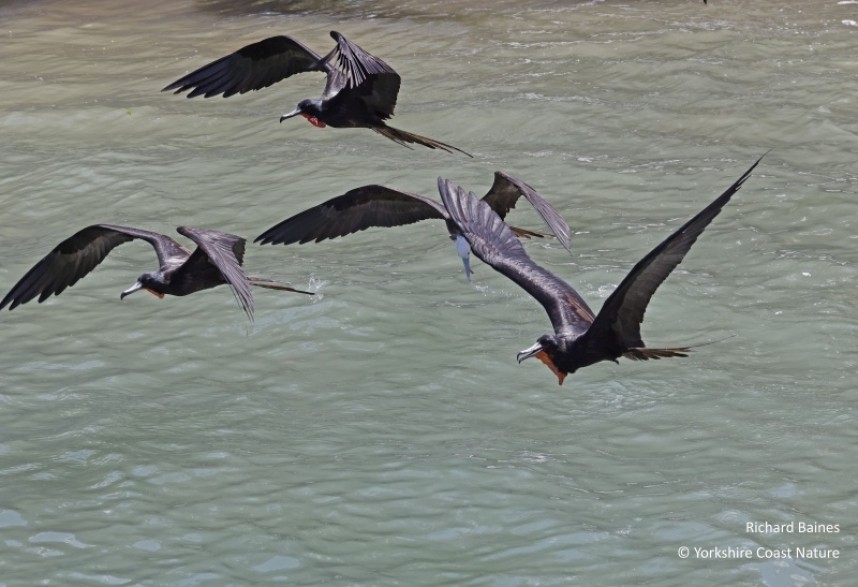
Magnificent Frigatebirds - St Lucia Nov 2022 © Richard Baines
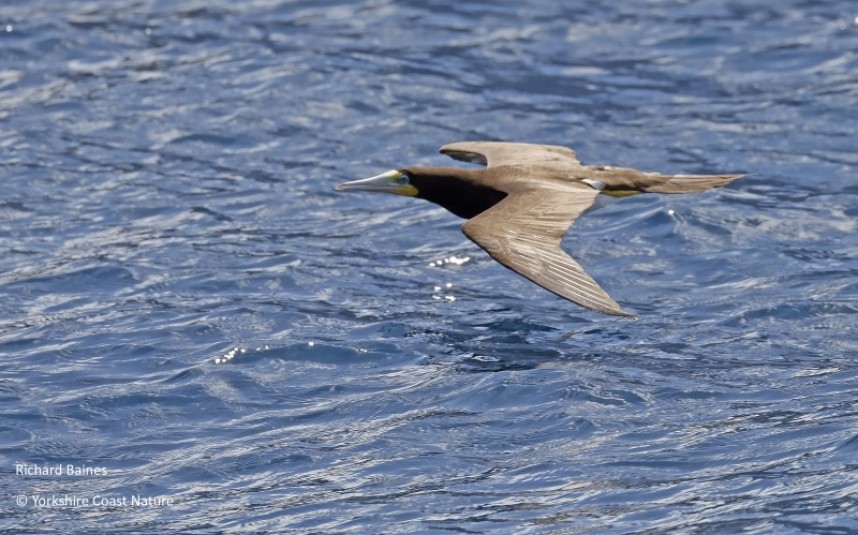
Brown Booby - Dominica Nov 2022 © Richard Baines
As soon as we landed on Dominica, I got a sense of pride amongst the local people who for the most part really cared about their ‘island of nature’. With less than half the population of St Lucia, Dominica is an island where everyone seems to know everyone else. Car horns are sounded with a brief beep as a greeting in every village, a friendly vibe which made us feel welcome. Dominica was hit hard by the 2017 hurricane Maria a category 5 storm which was recorded as the deadliest in living memory. Despite the hurricane people have re-built their lives but it was constantly humbling to see how people live their life as best they can with wild weather as a constant threat.
The day after we arrived, we were out with the best and only resident birding guide on the island, the famous Dr Birdy (Bertrand Jono Baptiste). Birdy’s priority was showing us his beloved Imperial Parrot, endemic to Dominica. The largest Amazonian parrot in the world and one of the most endangered with less than 500 on this tiny island. The forest of Morne Diablotin was our first destination walking the Syndicate trail. After a short stroll we were overlooking a huge forested valley scanning the trees for parrots.
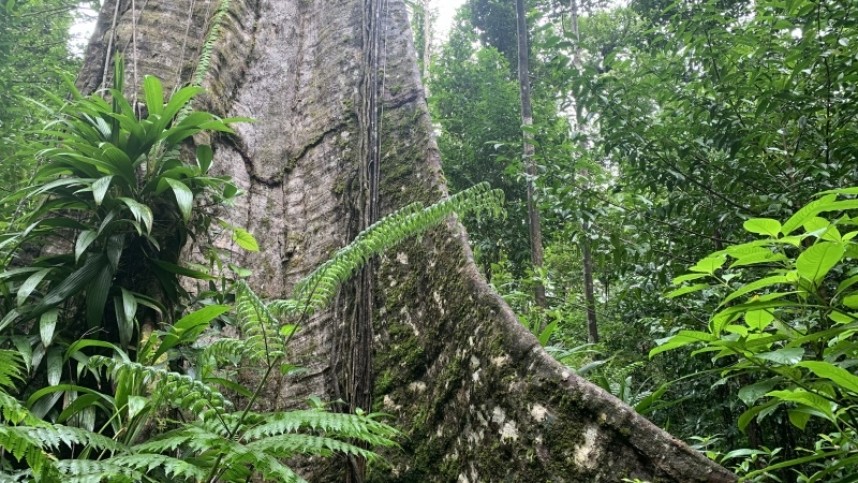
The famous 700 year old Chatanneye Ti-Fey Sloanea caribae tree on the Syndicate Trail - Dominica Nov 2022 © Richard Baines
Birdy described the call of the Imperial, ‘like nothing else you have ever heard, more like a raptor than a parrot’. In the distance he caught a brief sound but then nothing. The mist and rain rolled over the distant canopy like a blanket. The second and more common Red-necked Parrot put in an appearance with several small groups in flight but we had to be very patient for the true Imperial.
After a couple of serene hours watching from the viewpoint Jo caught a brief glimpse of a huge bird overhead. ‘That’s an Imperial,’ shouted Birdy. I hurried towards them and got on to the bird as it dropped into the forest. Thankfully it landed high in one of its favourite trees to feed on the pods of the Gommier tree (Dacryodes excelsa). Through Birdy’s scope we could see this magnificent parrot really well, its dark head contrasting with its bright green wings and darker tail. On the way back to the car we found yet another endemic bird treat in the form of a very smart Plumbeous Warbler.
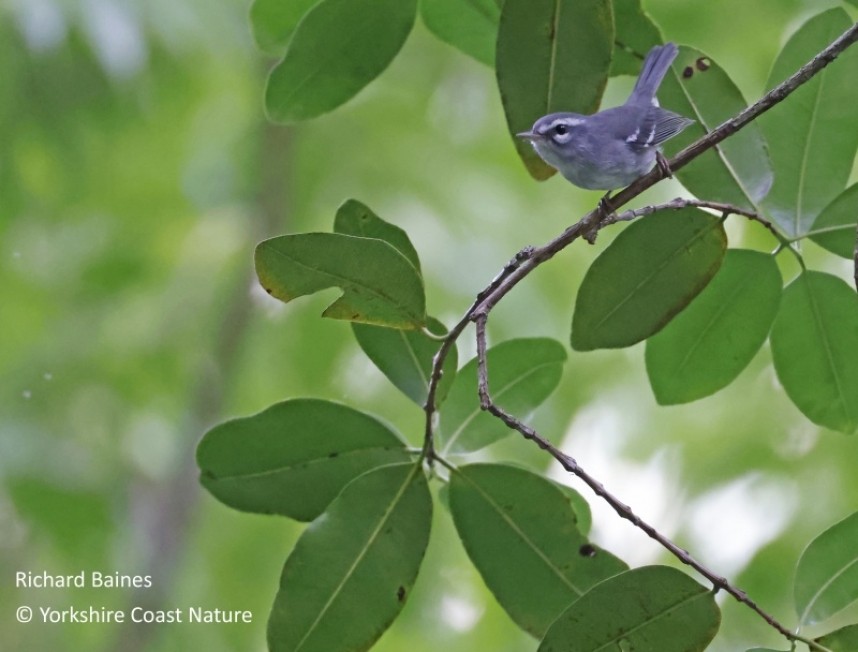
Plumbeous Warbler - Dominica Nov 2022 © Richard Baines
After the lucky and great view of the Imperial, it was time to drink in the experience and hear some of Birdy’s stories about this amazing bird. He told us how worried he was after the hurricane about the fate of the forest and these precious birds. Shortly after the storm he sat in tears at the viewpoint seeing the devastation for the first time. These tears then turned to joy on a later visit as he watched a group of parrots in the nearby trees. On this visit a visiting reporter asked him to talk into camera about how 80% of the parrots had been killed. He rightly refused because he really didn’t know how many had perished. Now five years later after keeping meticulous records of every sighting, his notes reflect a very similar pattern of activity and numbers to before the hurricane so rather than a grim 80% loss he is quietly optimistic about the future fortunes of the Imperial Parrot.
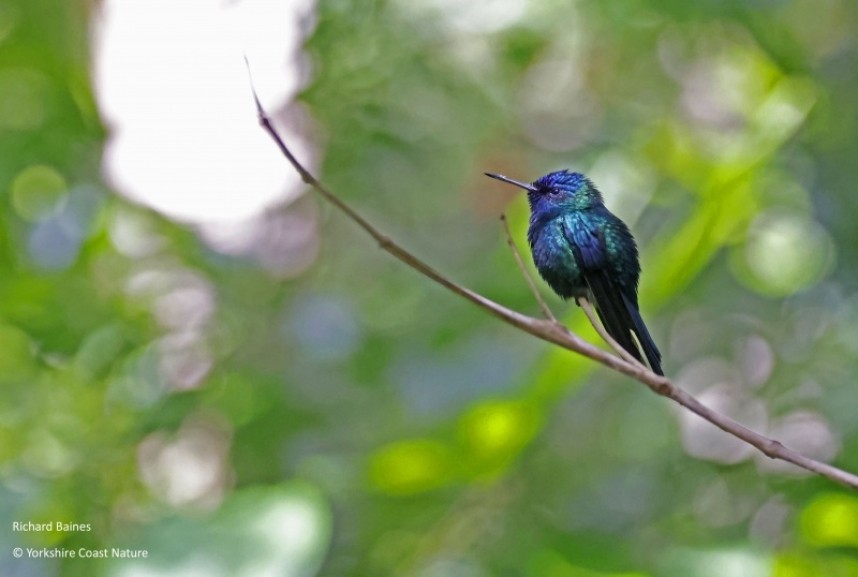
Blue-headed Hummingbird - Dominica Nov 2022 © Richard Baines
On the same forest trail as the biggest Amazonian in the world is a member of the smallest family of birds in the world; the near endemic (Dominica and Martinique) Blue-headed Hummingbird. This was our fourth hummingbird of the trip, the rarest of the four and the only one restricted to tropical forest above 800m. Having fallen in love with hummingbirds in Costa Rica many years ago I am constantly fascinated at the slightly different behaviour of each species.
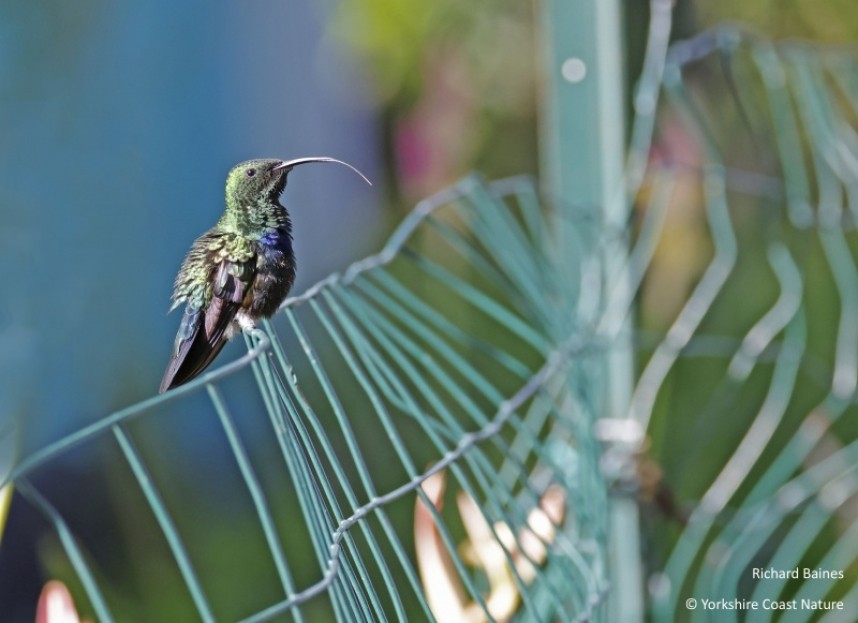
Green-throated Carib - Dominica Nov 2022 © Richard Baines
On this trip I made the following observations. The Purple-throated Caribs occupy many different habitats but mostly lowland and they boss the parks and gardens, defending regularly used perches and are consequently the easiest to photograph. The Green-throated Carib have a similar behaviour but are not so dominant and seem to use a greater range of flowering shrubs within each territory than the Purple-throated. The Antillean Crested Hummingbirds are the smallest, fastest and seem to use many different flowers within a territory, spending only a short amount of time at each flower. I spent three hours watching a Jasmine flower waiting for a male to return for a photograph. He returned four times in the three hours spending less than 10 seconds at the flowers on the small branch each time.
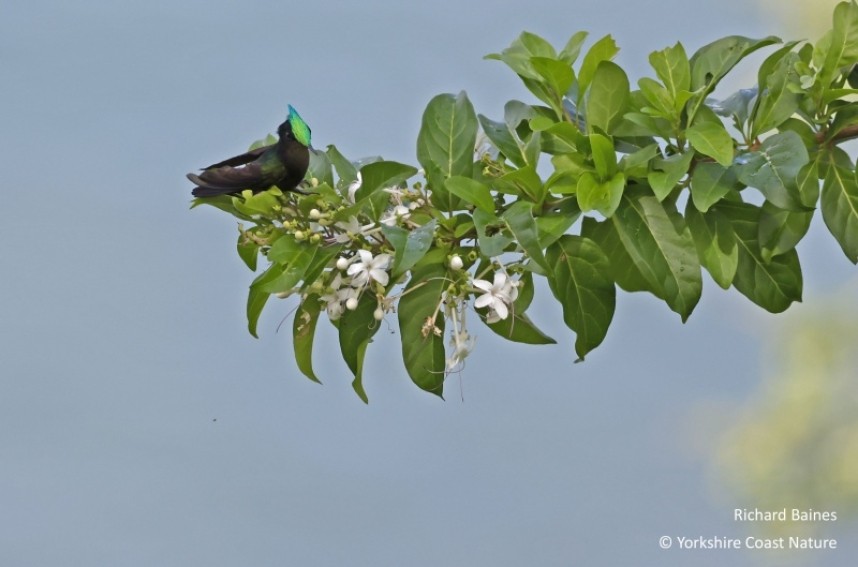
Antillean Crested Hummingbird - Dominica Nov 2022 © Richard Baines
The beautiful male Blue-throated Hummingbird on the Syndicate track had a very well-defined what appeared to be a linear territory covering a short length of track and an array of small flowers within the dappled light of the high forest. He used lookout perches regularly and spent far longer on the perches than the Antillean Crested fidget!
Our second day with Birdy was arranged with a later pick up, the luxury of a sit-down breakfast at Tamarind Tree Hotel. I couldn’t let the first two hours of daylight go to waste without birding so I took an early morning stroll down the track and beyond the main road. The broad-leaved secondary forest was lush with occasional rain showers and a hot sun. I was watching two strikingly coloured Yellow or Golden Warblers (near endemic resident subspecies ruficapilla) when another slower feeding small bird caught my eye. On brief views it looked like another New World warbler and the second time I saw it I was fairly sure it was a Tennessee Warbler but I needed a photo.
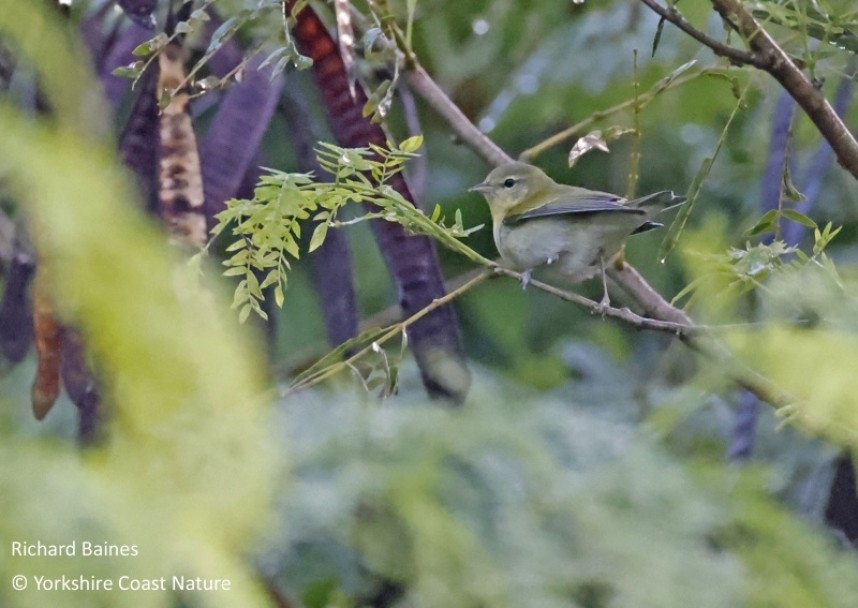
Tennessee Warbler - Dominica Nov 2022 © Richard Baines
After lots of attempts I finally got confirmation. After consulting Ryan Chenery’s new book ‘Birds of the Lesser Antilles’ I knew I was on to a rare bird because Tennessee Warbler was not in his book! When Birdy arrived to collect us, I told him of my find, he was impressed and said he didn’t think he had ever seen one on Dominica. A message to Ryan confirmed how good the find it was as there have only been a handful of records on the Lesser Antilles and none on Dominica! I felt very lucky, excited but disappointed I couldn’t share my find with Birdy, despite searching the next two mornings I couldn’t find it again.
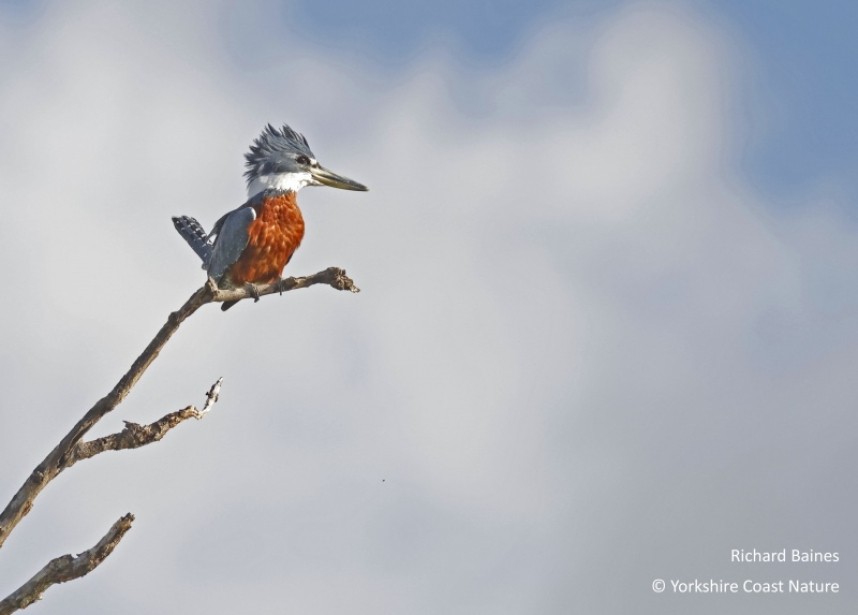
Ringed Kingfisher - Dominica Nov 2022 © Richard Baines
After the excitement of the morning, I was the most chilled I could have possibly been for the rest of the day. We spent more time on the Syndicate Trail enjoying the Blue-throated Hummingbird and then a really fun Indian River Cruise in the late afternoon. The small rowing boat trip into the mangrove swamps was my best opportunity to photograph the massive Ringed Kingfisher and just before our boat trip ended, I found a fantastic kingfisher perched up high which we managed to approach in the small quiet boat. Our boat captain James ‘Bond’ did a great job of sneaking closer to get my best possible photo.
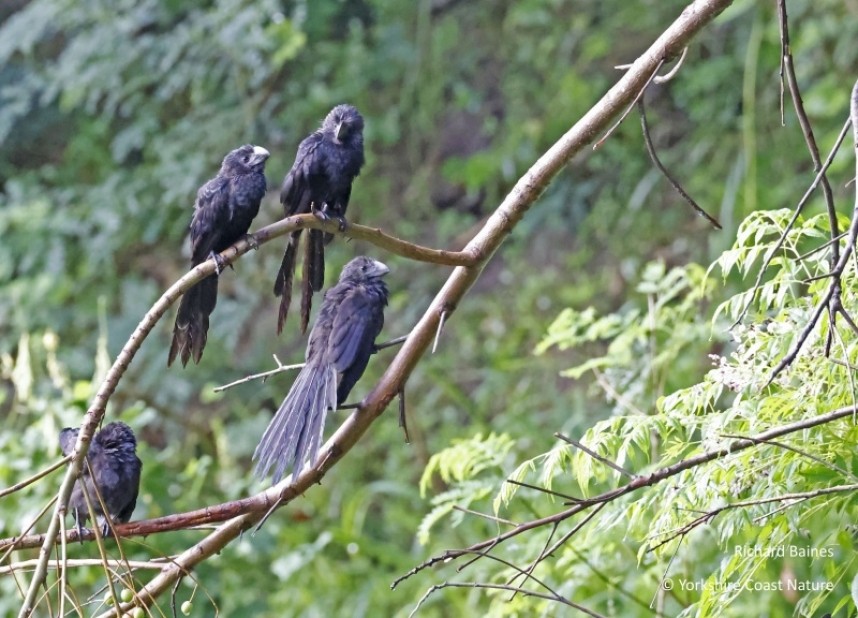
Smooth-billed Ani - Dominica Nov 2022 © Richard Baines
Our final day on Dominica was spent chilling and birding around Tamarind Tree where there were great opportunities for watching a wide variety of near endemics and a few migrants such as Blackpoll Warbler. The mature Tamarind Tree by the hotel reception was a very poplar feeding tree for a flock of Smooth-billed Ani. What fantastic birds these are. So crazy looking, very comical and highly social in their tight group. After a heavy rain shower it was great to watch them drying out, mutual preening, and swapping chit chat with each other! Later the same evening the local Lesser Antillean Swifts came down to feed above the forest. As the light dropped further, the swifts were replaced by bats and then came a North American Merlin swooping down over the hillside chasing a bat. A spectacular ending to a wonderful visit to Dominica.
Over the course of ten days birding, we saw 77 species. I always find it interesting to count up my list at the end of a trip even though I don’t rush around trying to see as many species as possible. I find it far more exciting to spend more time drinking in the experience and then I get an opportunity to find island a rarity such as the Tennessee Warbler.
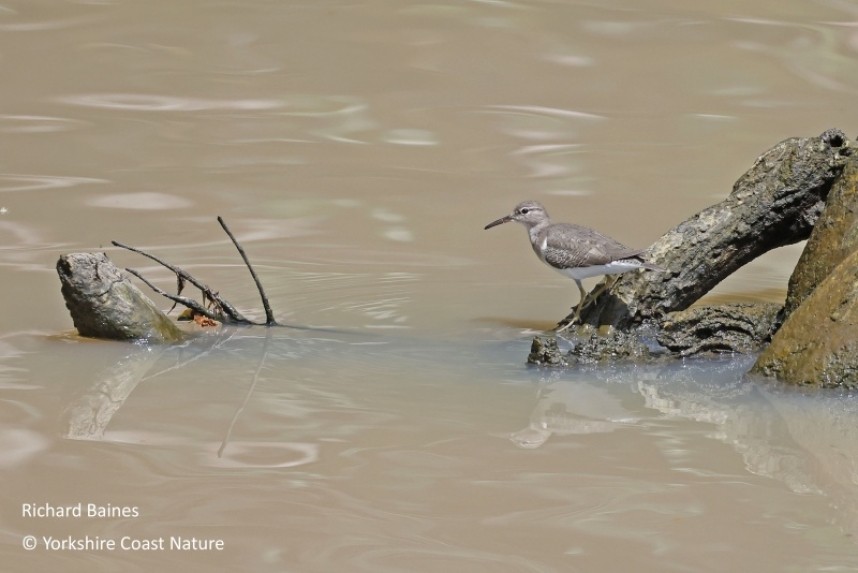
Spotted Sandpiper - St Lucia Nov 2022 © Richard Baines
The time of year of our visit meant there was very little wader passage, we only saw one species of wader; Spotted Sandpiper and no wildfowl apart from the local semi-domesticated Muscovy Ducks which were not counted. Out of our 77 species 27 were endemics (a species or subspecies only found on one island or region) and three were near endemics. An incredible 39% of our sightings were species or subspecies unique to at least one island in the Lesser Antilles and/or Caribbean, and found no-where else in the world!
Yorkshire Coast Nature RB Ltd has made a donation of £250 to Birds Caribbean towards their critical conservation work in the region. We hope this donation makes a small difference and helps this amazing place.
Taxonomy and nomenclature in this blog follow; Kirwan, G.M., Levesque, A., Oberle, M. & Sharpe, C.J. (2019). Birds of the West Indies. Lynx and BirdLife International Field Guides. Lynx Edicions, Barcelona.
© Yorkshire Coast Nature



 Back to Blog
Back to Blog
